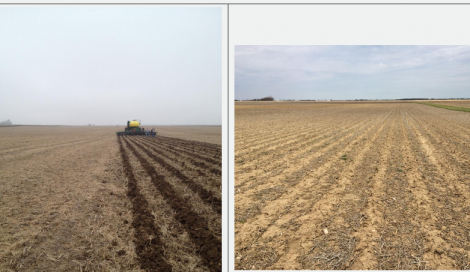- شما هیچ آیتمی در سبد خرید خود ندارید
- قیمت کل: 0 تومان
Tillage is traditionally done to prepare a seed bed for planting or mechanical weed control. It can also be used to manage soil moisture/ temperature through the manipulation of residue cover. Tillage is also used to incorporate inputs such as soil-activated, pre-emergence herbicides and broadcast nutrient applications. Tillage happens in association with the planting of annual or perennial seeded crops or transplants
No-till
The soil is left undisturbed from harvest to planting. Planting or drilling is accomplished using disc openers, coulter(s), row cleaners, in-row chisels or roto-tillers equiped on the planter frame. Weed control is accomplished primarily with crop protection products. Other common terms used to describe No-till include direct seeding, slot planting, zero-till, row-till, and slot-till.
Figures 38a and 38b. Residue cover for corn (38a) and soybeans (38b) in a no-till system. Credit for both images: Greg LaBarge, OSU Extension

Strip-till
The soil is left undisturbed from harvest to planting except for strips up to 1/3 of the row width (strips may involve only residue disturbance or may include soil disturbance). Planting or drilling is accomplished using disc openers, coulter(s), row cleaners, in-row chisels or roto-tillers planted into the prepared strips. Weed control is accomplished primarily with crop protection products. Cultivation may be used for emergency weed control.
Figures 39a and 39b. Strip-till system planting (39a) and afterplanting residue cover (39b). Credit for both images: Greg LaBarge, OSU Extension

Ridge-till
The soil is left undisturbed from harvest to planting except for strips up to 1/3 of the row width. Planting is completed on the ridge and usually involves the removal of the top of the ridge. Planting is completed with sweeps, disk openers, coulters, or row cleaners. Residue is left on the surface between ridges. Weed control is accomplished with crop protection products (frequently banded) and/or cultivation. Ridges are rebuilt during row cultivation.
Figures 40a and 40b. Ridge-till system planting (40a) and afterplanting residue cover (40b). Credit for both images: Randall Reeder, OSU Extension.

Considerations
Maintaining a targeted level of 30 percent residue cover after planting is recommended to provide enough cover to reduce soil losses. NRCS’ guide Farming With Crop Residue provides a pictorial view of residue at different levels of cover in corn and soybean production systems.
Reducing tillage results in system changes that must be accounted for to be successful. Drainage, pH and weed problems should be addressed before moving to no-till.
Drainage and soil type considerations in adoption of no-tillage.
pH and Liming
Cost
Cost of equipment and the required horsepower for the tractor are the major capital costs required to change tillage systems for the farm. Used equipment may be available that will lower the initial cost of the switch. A second consideration will be labor required. Due to actual number of passes involved in the new system vs current practices, more or less labor may be involved.
Residue provides a protective cover to the soil that reduces the energy of raindrops hitting the soil surface. This reduces soil-particle detachment and, ultimately, sheet and rill soil erosion. More intensive tillage systems introduce oxygen, which results in oxidation of organic matter. The short-term benefit of oxidation of organic matter is the release of plant-available nutrients, but the long-term impact of reduced organic matter is the reduction in water holding capacity, loss of soil tilth, and the natural nutrient cycling capacity of the soil. For each 1 percent increase in soil organic matter, water holding capacities increase .75–۱ inch (USDA-NRCS). Less intense tillage systems, especially no-till, result in lower soil disturbance and reduced losses of organic matter. This results in a slow building of organic matter percentage.
Lower intensity tillage systems conserve fuel and reduce labor needs on the farm. Less soil disturbance equals less horsepower needed per pass. Tillage passes can be replaced by a pass made with spray equipment making an herbicide application.
Reference
https://agbmps.osu.edu/bmp/tillage-intensity-maintain-target-residue-cover-nrcs-329-345-346
.



